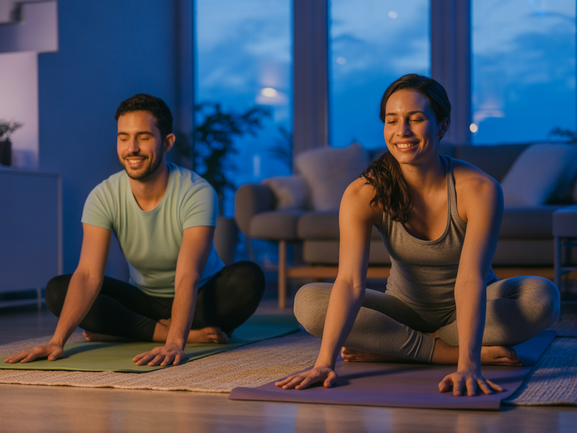Yoga for Beginners: Your First Steps to Body Movement and Mindfulness
Have you ever watched someone gracefully flow through yoga poses and thought, “That looks amazing, but I could never do that”? You’re not alone. Many people believe yoga requires perfect flexibility, expensive equipment, or years of experience. The truth is, yoga for beginners starts exactly where you are right now.
Whether you’re dealing with daily stress, spending long hours at a desk, or simply want to reconnect with your body, yoga offers a gentle path to physical and mental wellness. Moreover, you don’t need to be flexible, strong, or spiritually enlightened to begin. You just need to take that first step.
Why Start Yoga? The Life-Changing Benefits for Beginners
When you begin practicing yoga at home for beginners, you’re not just stretching your body – you’re investing in your overall well-being. Here are the immediate benefits you can experience:
- Reduced stress and anxiety: Even 10 minutes of gentle movement can calm your nervous system
- Improved flexibility: Your body will gradually become more mobile with consistent practice
- Better sleep quality: Evening yoga helps prepare your mind and body for rest
- Enhanced focus: The mind-body connection strengthens your ability to concentrate
- Pain relief: Gentle stretches can alleviate common aches from daily activities
The beauty of yoga lies in its accessibility. You don’t need to master complex poses immediately; instead, focus on simple movements that feel good in your body.
Essential Beginner Yoga Poses: Your Foundation Practice
Let’s explore five beginner yoga poses that form the foundation of any practice. Remember, these are starting points – listen to your body and modify as needed.
1. Mountain Pose (Tadasana)
This fundamental pose teaches proper alignment and body awareness. Stand tall with feet hip-width apart, arms at your sides. Feel your feet rooted to the ground while the crown of your head reaches toward the sky. Breathe deeply for 30 seconds to 1 minute.
2. Child’s Pose (Balasana)
A restful pose that stretches your hips, thighs, and ankles. Kneel on the floor, touch your big toes together, and sit back on your heels. Separate your knees and fold forward, extending your arms in front of you. This pose is perfect for taking breaks during practice.
3. Cat-Cow Stretch
Start on your hands and knees in a tabletop position. Inhale, arch your back and look up (Cow). Exhale, round your spine and tuck your chin (Cat). This gentle flow warms up your spine and releases tension.
4. Downward Facing Dog (Modified)
From tabletop position, tuck your toes and lift your hips up and back. Don’t worry about straight legs – bend your knees as much as needed. This pose strengthens your arms while stretching your entire back body.
5. Corpse Pose (Savasana)
Lie on your back with arms and legs relaxed. Close your eyes and focus on your breath. This final relaxation pose allows your body to integrate the benefits of your practice.
These simple yoga movements create a complete beginner sequence. Start with 5-10 minutes daily, gradually increasing as you feel more comfortable. Additionally, remember that consistency matters more than duration or perfection.
Creating Your Home Practice Space
One advantage of yoga is that you can practice anywhere. However, creating a dedicated space can help establish your routine. You’ll need:
- A yoga mat (or towel on a non-slip surface)
- Comfortable, stretchy clothing
- A quiet space with enough room to extend your arms
- Optional props: blocks, blanket, or pillow for support
Most importantly, choose a time that works for you. Whether it’s morning energy, lunch break stress relief, or evening relaxation, consistency will help you develop a sustainable practice.
Getting Started with Guided Support
While practicing independently is wonderful, having guidance can accelerate your progress and ensure proper alignment. Vitalizen.app offers specially designed beginner programs that take the guesswork out of starting your yoga journey.
Our yoga app for beginners features:
- Step-by-step video instructions for proper alignment
- Customizable session lengths (5-60 minutes)
- Progress tracking to celebrate your improvements
- Gentle modifications for different body types and limitations
Ready to take your first step? Begin your wellness journey today with our beginner-friendly approach to yoga and mindfulness.
Frequently Asked Questions About Yoga for Beginners
Do I need to be flexible to start yoga?
Absolutely not! Flexibility is a result of yoga practice, not a prerequisite. Start where you are, and your flexibility will gradually improve with consistent practice. Every body is different, and yoga meets you exactly where you’re at.
How often should beginners practice yoga?
For beginners, 2-3 times per week is ideal. Short, consistent sessions (10-20 minutes) are more beneficial than occasional long practices. As you build strength and familiarity, you can gradually increase frequency and duration.
What’s the difference between yoga and stretching?
While yoga includes stretching, it also incorporates

